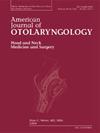Vocal fold lateralization by percutaneous suture in children: A systematic review
IF 1.7
4区 医学
Q2 OTORHINOLARYNGOLOGY
引用次数: 0
Abstract
Objectives
Percutaneous vocal fold lateralization (PVFL) consists of external fixation with non-absorbable percutaneous suture of the vocal fold in a lateral position, under direct glottic visualization. The objective, through a systematic review, was to identify, select, evaluate, and synthesize the relevant evidence available to define whether PVFL is effective in avoiding the tracheostomy, as well as whether it is effective in allowing decannulation of children who have already been tracheostomized. Secondarily, vocal quality, complications and reversibility of the procedure were evaluated.
Methods
A systematic review was carried out based on the protocols described in the QUORUM/PRISMA (Preferred Reporting Items for Systematic Reviews and Meta-analyses) guidelines. The search strategy was carried out in the PubMed, Embase, Scopus, Web of Science, SciELO and VHL databases. The terms searched were a combination of indexed keywords using Boolean terms. Inclusion criteria: Primary studies that documented intervention outcomes in patients with BVFP; Studies including pediatric patients (defined here as <18 years of age); and studies with well documented postoperative follow-up. Exclusion criteria: Duplicate studies or with the same clinical data; articles that exclusively evaluated other surgical interventions, animal studies, reviews, or post-mortem studies; and studies with only patients with unilateral vocal fold paralysis.
Results
Among the patients under study, 80 cases, underwent the surgical technique under study, 41 of these (51.25 %) are male. The average age of patients undergoing the procedures ranged from 4 days to 10 years of age. Most patients already had preoperative comorbidities, generally cardiothoracic and laryngeal, followed by neurological causes. In 31 % of patients, only a high-flow nasal catheter was required and in 3 patients, transient orotracheal intubation was required. At the mean follow-up of 30 months [SD:24], around 20 of the 80 (25.6 %) patients presented some degree of dysphonia. However, there was no standardization of scales. Approximately 11 % of patients had some postoperative complication, with reintubation due to glottic edema being the most prevalent. There was only 1 death. Preoperatively, 38 % of patients with BVFP were tracheostomized. After the procedure, only 13 % of them still needed to continue with the tracheostomy during the postoperative period. However, 13 % of patients needed to remain with a tracheostomy. Among the tracheostomy patients, only 3 of them achieved return of vocal fold mobility. Among all patients, vocal fold mobility returned in 35 % of patients, with a total of 10 % of patients postoperatively. However, there were studies that did not report mobility due to the short follow-up. During follow-up, 6 patients required revision procedures to relocate lateralization suture or even due to skin abscess. Granuloma occurred in only 1 case. There was just one study reporting suture removal in 3 of its cases.
Conclusions
PVFL is an effective and safe procedure, either due to its high rates of avoiding tracheostomy and allowing decannulation, in addition to the potential for reversibility, or due to its low invasiveness, and can be used to treat PBPV in newborns and infants. However, more controlled studies are needed with longer follow-up of patients, with objective outcomes in the assessment of dysphonia and swallowing, in addition to assessing the incidence of long-term complications. Randomized, multicenter clinical trials are welcome to allow for a larger sample, comparing the efficacy and adverse effects of PVFL in relation to tracheostomy and other existing endoscopic procedures.
经皮缝合儿童声带侧边:系统回顾
目的经皮声带侧边固定术(PVFL)是在声门直视下,用不可吸收的经皮声带缝线将声带侧边固定。本研究的目的是通过系统回顾,识别、选择、评估和综合现有的相关证据,以确定PVFL是否有效避免气管造瘘,以及是否有效允许已气管造瘘的儿童脱管。其次,评估声带质量、并发症和手术的可逆性。方法根据QUORUM/PRISMA(系统评价和荟萃分析首选报告项目)指南中描述的方案进行系统评价。在PubMed、Embase、Scopus、Web of Science、SciELO和VHL数据库中进行检索策略。搜索的术语是使用布尔术语的索引关键字的组合。纳入标准:记录BVFP患者干预结果的初步研究;研究对象包括儿科患者(此处定义为18岁);以及术后随访的研究。排除标准:重复研究或具有相同临床数据;专门评价其他手术干预、动物研究、综述或死后研究的文章;研究对象只有单侧声带麻痹的患者。结果80例患者中,男性41例,占51.25%。接受手术的患者平均年龄从4天到10岁不等。大多数患者术前已经有合并症,通常是心胸和喉部,其次是神经系统原因。31%的患者只需要高流量鼻导管,3例患者需要短暂的口气管插管。平均随访30个月[SD:24], 80例患者中约有20例(25.6%)出现不同程度的语音障碍。然而,没有标准化的量表。大约11%的患者出现了一些术后并发症,其中最常见的是声门水肿。只有一人死亡术前,38%的BVFP患者进行了气管造口术。手术后,只有13%的患者在术后仍需要继续气管切开术。然而,13%的患者需要继续进行气管切开术。气管切开术患者中,仅有3例患者实现了声带活动的恢复。在所有患者中,35%的患者声带活动恢复,其中10%的患者术后声带活动恢复。然而,也有研究没有报告由于随访时间短而导致的活动能力。随访期间,6例患者因侧线移位或皮肤脓肿需要翻修手术。仅1例发生肉芽肿。只有一项研究报告了其中3例的拆线。结论spvfl是一种有效且安全的手术方法,既可避免气管切开术并允许脱管,又具有可逆性,又具有低侵入性,可用于新生儿和婴儿PBPV的治疗。然而,需要更多的对照研究,对患者进行更长的随访,除了评估长期并发症的发生率外,还需要客观的结果来评估语音障碍和吞咽。随机、多中心临床试验是受欢迎的,以允许更大的样本,比较PVFL与气管切开术和其他现有内窥镜手术的疗效和不良反应。
本文章由计算机程序翻译,如有差异,请以英文原文为准。
求助全文
约1分钟内获得全文
求助全文
来源期刊

American Journal of Otolaryngology
医学-耳鼻喉科学
CiteScore
4.40
自引率
4.00%
发文量
378
审稿时长
41 days
期刊介绍:
Be fully informed about developments in otology, neurotology, audiology, rhinology, allergy, laryngology, speech science, bronchoesophagology, facial plastic surgery, and head and neck surgery. Featured sections include original contributions, grand rounds, current reviews, case reports and socioeconomics.
 求助内容:
求助内容: 应助结果提醒方式:
应助结果提醒方式:


